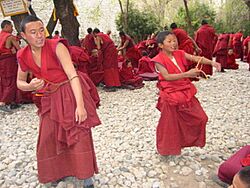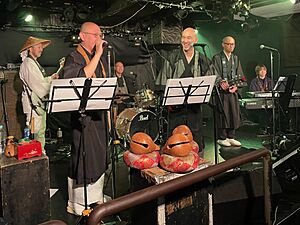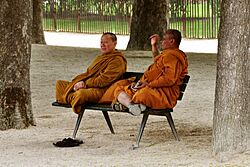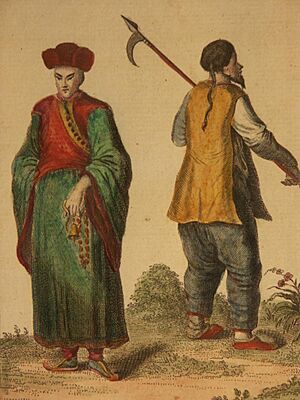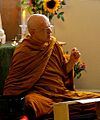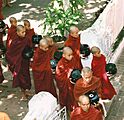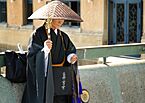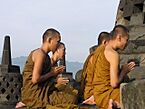Bhikkhu facts for kids
Quick facts for kids Bhikkhu |
|||||||||
|---|---|---|---|---|---|---|---|---|---|

Bhikkhus in Thailand
|
|||||||||
| Chinese name | |||||||||
| Chinese | 比丘 | ||||||||
|
|||||||||
| Native Chinese name | |||||||||
| Chinese | 和尚、僧侶 | ||||||||
|
|||||||||
| Burmese name | |||||||||
| Burmese | ဘိက္ခု | ||||||||
| Tibetan name | |||||||||
| Tibetan | དགེ་སློང་ | ||||||||
|
|||||||||
| Vietnamese name | |||||||||
| Vietnamese alphabet | Tì-kheo (Tỉ-khâu) Tăng lữ |
||||||||
| Chữ Hán | 比丘 僧侣 |
||||||||
| Thai name | |||||||||
| Thai | ภิกษุ | ||||||||
| RTGS | phiksu | ||||||||
| Japanese name | |||||||||
| Kanji | 僧、比丘 | ||||||||
|
|||||||||
| Tamil name | |||||||||
| Tamil | துறவி, tuṟavi | ||||||||
| Sanskrit name | |||||||||
| Sanskrit | भिक्षु (Bhikṣu) |
||||||||
| Pali name | |||||||||
| Pali | Bhikkhu | ||||||||
| Khmer name | |||||||||
| Khmer | ភិក្ខុ UNGEGN: Phĭkkhŏ ALA-LC: Bhikkhu |
||||||||
| Nepali name | |||||||||
| Nepali | भिक्षु | ||||||||
| Sinhala name | |||||||||
| Sinhala | භික්ෂුව | ||||||||
| Telugu name | |||||||||
| Telugu | భిక్షువు, bhikṣuvu | ||||||||
| Odia name | |||||||||
| Odia | ଭିକ୍ଷୁ, Bhikhyu | ||||||||
A bhikkhu is a male who has been ordained (officially joined) the Buddhist monastic community. In Buddhism, both male and female monastics are part of the Sangha, which is the Buddhist community. Female monastics are called bhikkhunīs.
The lives of all Buddhist monastics follow a special set of rules. These rules help them live a simple, meditative life. Their main goal is to achieve nirvana, a state of perfect peace and freedom.
A person must be at least 20 years old to become a full bhikkhu or bhikkhuni. If they are younger, they can become a śrāmaṇera (novice monk) or śrāmaṇērī (novice nun).
Contents
What is a Bhikkhu?
The word Bhikkhu means "beggar" or "one who lives by alms (donations)". The historical Buddha, Prince Siddhartha, gave up his royal life. He chose to live simply, asking for food as a mendicant (someone who lives by begging).
His serious students also adopted this simple lifestyle. These full-time students became the first ordained monastics. They traveled from town to town, living off alms. They would only stop in one place during the Vassa, which are the rainy months.
In a famous Buddhist text called the Dhammapada, a bhikkhu is described as someone who "sees danger" in the cycle of rebirth (called samsara). This means they want to escape this cycle. So, they become ordained to find freedom from it.
The Dhammapada also says:
[266-267] He is not a monk just because he lives on others' alms. Not by adopting outward form does one become a true monk. Whoever here (in the Dispensation) lives a holy life, transcending both merit and demerit, and walks with understanding in this world — he is truly called a monk.
The Buddha later allowed women to become bhikkhunis. His step-mother, Mahapajapati Gotami, became the first bhikkhuni. Other women then followed, undergoing full ordination to become nuns.
Becoming a Bhikkhu: Ordination
Becoming a bhikkhu involves a special ceremony called ordination. This process is a bit different depending on the Buddhist tradition.
Theravada Tradition
In the Theravada tradition, the rules for monastics are found in the Vinaya Pitaka.
- Going Forth (Novitiate): First, a layperson (someone not ordained) can become a novitiate. This is called the "going forth" (Pali: pabbajja). Novitiates follow the Ten Precepts.
- Full Ordination: After being a novitiate, a person can undergo full ordination (Pali: upasampada). Fully ordained bhikkhus follow a much longer set of rules called the Pātimokkha.
Mahayana Tradition
In the Mahayana tradition, becoming a monastic is part of taking "vows of individual liberation." These vows help monks and nuns develop strong ethical behavior.
There are four main steps to taking these vows:
- Lay Vows: A lay person can take five upāsaka and upāsikā vows.
- Monastic Way of Life: The next step is to enter the monastic way of life (Skt: pravrajyā). This includes wearing the special robes of a monk or nun.
- Novice: After that, one can become a novice (Skt. śrāmaṇera for males, śrāmaṇeri for females).
- Full Ordination: The final step is to take all the vows to become a fully ordained monastic (Sanskrit: bhikṣu for males, bhikṣuṇī for females).
Monastics usually take their vows for life. However, they can choose to leave the monastic life and return to a non-monastic life. They can even take the vows again later, usually up to three or seven times in one lifetime. This system helps keep the vows "clean" and shows that breaking them is seen as very serious.
In Japan, during the Meiji Restoration in the 1870s, the government changed rules for Buddhist monastics. They removed rules about celibacy (not marrying) and vegetarianism. This was done to make them more like regular people. Today, many Buddhist priests in Japan can marry and have families.
In Korea, the practice of celibacy also varies. Some Buddhist orders, like the Jogye Order, are fully celibate. Others, like the Taego Order, have both celibate monastics and non-celibate priests.
Vajrayana Tradition
In Tibet, young people can take different ordinations at different ages. For example, lay vows are often taken around age six, the monastic way of life around fourteen, and full ordination at twenty-one or older.
Tibetan Vajrayana often calls ordained monks lamas.
Additional Vows
In Mahayana traditions, a Bhikṣu might take extra vows. These include the Bodhisattva vows, which are promises to help all living beings. These extra vows are often open to laypersons too.
Monastic Robes
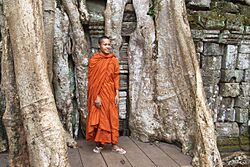
The special clothes worn by ordained monastics are called robes. They are meant to be simple and durable, protecting the body from weather. The color and style of robes are usually the same within each tradition. The color often depends on what dyes were easily available in that region.
- In Tibet and the Himalayan regions, red is a common color.
- In Myanmar, reddish-brown is often seen.
- In India, Sri Lanka, and Southeast Asia, you'll find shades of yellow, ochre, and orange.
- In China, Korea, Japan, and Vietnam, gray or black robes are common.
Monks often make their own robes from cloth given to them as donations.
During a special ceremony called the Kathina Puja, a unique robe is made in 24 hours from donations. This robe is given to a temple or monastery. The monks living there then choose one monk to receive this special robe.
Historical Terms in Western Literature
Before the mid-1900s, Western writers sometimes used the word bonze to refer to Buddhist monks, especially from East Asia. This word came from Portuguese and French. It is rarely used today.
Another old term for Buddhist monks was talapoy or talapoin. This word came from Portuguese and ultimately from a Mon language term meaning "our lord."
The talapoin monkey is named after Buddhist monks. This is similar to how the capuchin monkey is named after the Capuchin friars, a Christian monastic order.
Gallery
-
A Buddhist monk in the U.S. (Chinese Buddhism)
-
Monks in Luang Prabang, Laos
-
Monks in Thailand
See also
- Bhante
- Sayadaw
- Ajahn
- Samanera
- Oshō
- Anagarika
- Bhikkhuni
- Unsui


